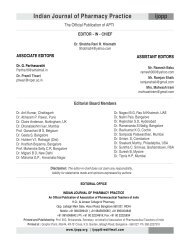Oct-Dec, 2011 - Indian Journal of Pharmacy Practice
Oct-Dec, 2011 - Indian Journal of Pharmacy Practice
Oct-Dec, 2011 - Indian Journal of Pharmacy Practice
- No tags were found...
Create successful ePaper yourself
Turn your PDF publications into a flip-book with our unique Google optimized e-Paper software.
Pratham R - A Retrospective Study <strong>of</strong> Nosocomial infections in Patients Admitted in M.I.C.Umore significance in resource-poor countries, especiallythose affected most by HIV/AIDS, because recent findingsstrongly suggest that unsafe medical care may be an important13factor in transmitting HIV . During the past 10–20 years littleprogress has been made in addressing the basic problemsresponsible for the increasing rates <strong>of</strong> nosocomial infectionsin many countries, and in some countries, conditions areactually worsening. Nosocomial infections increase the cost<strong>of</strong> healthcare in the countries least able to afford them throughincreased: length <strong>of</strong> hospitalization; treatment with expensivemedications (e.g., antiretroviral drugs for HIV/AIDS andantibiotics); and use <strong>of</strong> other services (e.g., laboratory tests,X-rays and transfusions).As a consequence, in resource poor countries, efforts toprevent nosocomial infections must assume even greaterimportance if progress is to be made in improving the quality<strong>of</strong> patient care in hospitals and other healthcare facilities.Most <strong>of</strong> these infections can be prevented with readilyavailable, relatively inexpensive strategies by adhering torecommended infection prevention practices, especially handhygiene and wearing gloves; paying attention to wellestablishedprocesses for decontamination and cleaning <strong>of</strong>soiled instruments and other items, followed by eithersterilization or high-level disinfection; and improving safetyin operating rooms and other high-risk areas where the mostserious and frequent injuries and exposures to infectiousagents occur.CONCLUSIONIn study, the geriatric population is highly vulnerable tonosocomial infections. Geriatric patients have defective hostdefenses that compromise their ability to ward <strong>of</strong>f infectiousagents. Our findings are similar to observations made in otherstudies in literature. Urinary tract infections and pneumoniasare the common nosocomial infections. Our study alsoreveals that the incidence <strong>of</strong> infections increases with use <strong>of</strong>invasive devices. Early recognition <strong>of</strong> infections restrictedand short term use <strong>of</strong> invasive devices can therefore,contributes significantly towards decreasing the incidence <strong>of</strong>nosocomial infections in geriatric patients. We suggest thatsystematic and standardized large scale studies be carried outon elderly population for prevention and management <strong>of</strong>nosocomial infections. Early recognition <strong>of</strong> infections,restricted and short term use <strong>of</strong> invasive devices can therefore,contribute significantly towards decreasing the incidence <strong>of</strong>nosocomial infections in elderly.ACKNOWLEDGEMENTSWe thank the research and ethical committee <strong>of</strong> N.M hospitaland heart center (Ghaziabad) for approving our study.REFERENCES1. Garner J.S, Jarvis W.R, Emory T.G, Horan T.C, Hughes J.M.CDC definitions for nosocomial infections. American <strong>Journal</strong> <strong>of</strong>Infection Control 1988; 16: 28-40.2. Strausbaugh L.J. Emerging Health Care associated infectionsin the geriatric population. Emerging Infectious Diseases2001; 7(2): 268-271.3. Taylor M.E, Oppenheim B.A. Hospital acquired infection inelderly patients. <strong>Journal</strong> <strong>of</strong> Hospital Infection 1998; 38: 245-260.4. Crossley K.B, Peterson P.K. Infection in elderly, principles andthpractice <strong>of</strong> infectious diseases. 5 edition Philadelphia, 2000;3164-3169.5. Emori T.G, Bannerjee S.N, Culver D.H. Nosocomial infectionsin elderly patients in United States. American <strong>Journal</strong> <strong>of</strong>Medicine 1991; 91 (3): 289-293.6. Richards M.J, Edwards J.R, Culver D.H. Nosocomialinfections in combined medical surgical intensive care units inU S. Infection Control Hospital Epidemiology 2000; 21: 510-515.7. Mukherjee T, Pramod K, Srinivasan G, Rao M.Y. Nosocomialinfections in geriatric patients admitted in ICU. <strong>Journal</strong> <strong>of</strong> The<strong>Indian</strong> Academy <strong>of</strong> Geriatric 2005, 2: 61-64.8. Beaujean D.J, Blok H.E, Grauls C.M. Surveillance <strong>of</strong>nosocomial infection in geriatric patients. <strong>Journal</strong> <strong>of</strong> HospitalInfection 1997; 36: 275-284.9. Richards MJ, Edwards JR, Culver DH, Gaynes RP.Nosocomial infections in medical intensive care units in UnitedStates. National nosocomial infection surveillance system.Critical Care Medicine 1999; 27: 887-892.10. Lee Y.L, Thrupp L.D, Friis R.H, Fine M, Maleki P, Cesario T.C.Nosocomial Infection and antibiotic utilization in geriatricpatients-a pilot prospective surveillance program in nursingfacilities. Gerontology 1992; 38: 223-232.11. Lee Y.L, Thrupp L.D, Friis R.H, Fine M, Maleki P, Cesario T.C.Nosocomial Infection and antibiotic utilization in geriatricpatients-a pilot prospective surveillance program in nursingfacilities. Gerontology 1992; 38: 223-232.12. Ponce-de-Leon S. The needs <strong>of</strong> developing countries and theresources required. J Hosp Infect 1991; 18: 376–381.13. Gisselquist D. HIV infections in sub-Saharan Africa notexplained by sexual or vertical transmission. Int J STD AIDS2002; 13(10): 657–666.<strong>Indian</strong> <strong>Journal</strong> <strong>of</strong> <strong>Pharmacy</strong> <strong>Practice</strong> Volume 4 Issue 4 <strong>Oct</strong> - <strong>Dec</strong>, <strong>2011</strong> 65
















